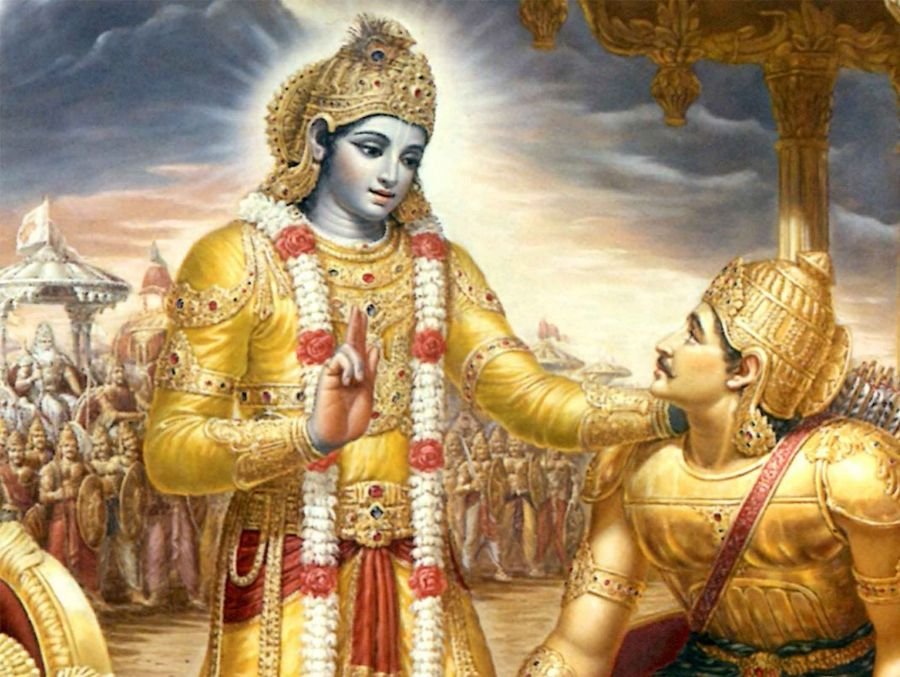(Image Courtesy Mahanidhiswami)
God Is The Source Of All Living Beings, The Place Where All Living Beings Are Located, And The Place Where All Living Beings Will Merge
अहमात्मा गुडाकेश सर्वभूताशयस्थित: |
अहमादिश्च मध्यं च भूतानामन्त एव च || 10.20||
aham ātmā guḍākeśha sarva-bhūtāśhaya-sthitaḥ
aham ādiśh cha madhyaṁ cha bhūtānām anta eva cha|| 10.20||
Shloka Translation
BG – Ch. 10- Ver. 20:
I am enthroned in the heart of all living beings, O Arjun. All entities have their beginning, middle, and end in me.
Explanation
Shree Krishna asserts that he is not distant from the soul in fact; he is the closest of all. All living beings have the atma, or eternal soul, enthroned in their etheric hearts. Our soul is where God resides. He offers the soul the power of consciousness and eternality while seated inside.
If he were to relinquish his power, our soul would become insensible and die. We are everlasting and sentient as a result of the supremely sentient and eternal God seated within us, who is granting us his powers. As a result, Shree
Krishna says that he is at the centre of all living things. Our soul is God’s body, and God is the Soul of our lives.
All living beings in the cosmos have a Supreme Soul, which is Lord Krishna. By his Yogmaya power, he has manifested in a human form for the sake of humanity. According to Shree Krishna, he is the beginning, middle, and end of all living entities. They have originated from him, and he is the source of their origins. His vitality sustains all life in creation, and he is thus the central figure. Those who achieve liberation are welcomed into his celestial dwelling, where they will spend eternity with him. As a result, God is also the final destination of all living things.
Verse & what we can learn
Ishvara is the “I” that resides in the hearts of all beings in the universe. Ishvara is also the beginning, middle, and end of all cosmic creatures. When we feel a sense of selfhood in our hearts, we should recognise it as Ishvara’s fundamental expression. We don’t need to recall any other manifestation of Ishvara if we can remember this all of the time, if we can regard everything and everyone as if they were us. We’ve completed our task.
Our feeling of self-awareness and my-ness naturally diminishes. Nothing in us will declare “my will,” “my plan,” “my thought,” “I am going to do this,” and so on. Ishvara’s will, Ishvara’s plan, Ishvara’s thinking, and Ishvara’s doing shall all be realized. Because the “I” who worries is no longer present, all worries and fears will vanish.
Shri Krishna provides another representation of Ishvara if we are unable to realize Ishvara as our own self. He claims that we should think of Ishvara as the one who produces, sustains, and dissolves all of the universe’s names and forms. If we can think of Ishvara in this way, he becomes all-pervasive and always present. When we are beginners, it is difficult to think of Ishvara as the self, or as the beginning, middle, and end of all creatures.
To acquire knowledge and to implement that knowledge in life one needs to be mentally and physically active and healthy and for that daily meditation is a great tool.
There are various types of meditation like Buddhist meditation, heartfulness meditation, mindfulness meditation, meditation for stress, and each meditation benefits are countless. There is also numerous meditation techniques for beginners which help in practicing daily meditation so go ahead and start your journey towards a peaceful and balanced life.
Ishvara is simpler to see in real people and things. In the shlokas that follow, we’ll see those kinds of expressions.
Let’s learn to live with “The Gita” via Meditation Affinity…
